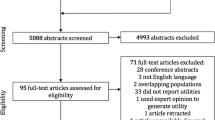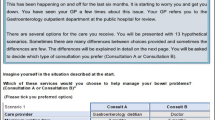Abstract
Background: Previous studies about patients who have undergone ostomy surgery commonly address the issues of the surgery, complications, preoperative counseling, quality of life, and psychosocial changes following surgery. Only a limited number of studies deal with how technical improvements in stoma care would affect patients and, to the author’s knowledge, the present study is the first to elicit preferences for potential improvements in ostomy pouches in the form of monetary values.
Objective: This article examines and measures Swedish patients’ preferences for potential improvements in ostomy pouch attributes. The theory, study design, elicitation procedure, and resulting preference structure of the sample is described.
Methods: A discrete-choice experiment (DCE) was used to elicit preferences. Respondents were asked to choose between alternatives in choice sets, in which each alternative comprised a number of attributes relating to the adhesive, filter, and flexibility of ostomy pouches. The choices between alternatives made by the respondent imply a trade-off between the attributes and allow for the estimation of individuals’ willingness to pay (WTP) for the attributes of ostomy pouches when cost is included as an attribute. A total of 254 patients responded to the survey and preferences were estimated using a random parameter logit econometric specification.
Results: Respondents had significantly positive WTP for all potential attribute improvements presented in the survey, with the strongest preference for reducing the number of leakages; flexibility of the system weighted second, and filter lifetime was the least important.
Conclusion: The results confirm that the potential attribute improvements presented to the respondents in this study significantly and positively affect the utility that patients would obtain from a potential improvement in their ostomy pouch. This provides information as to how treatment options in terms of stoma management can be structured so as to maximize the benefits for patients.






Similar content being viewed by others
References
Cataldo PA. Intestinal stomas: 200 years of digging. Dis Colon Rectum 1999; 42: 137–42
Nugent KP, Daniels P, Stewart B. Qualit of life in stoma patients. Dis Colon Rectum 1999; 42: 1569–74
Awad RW, el-Gohary TM, Skilton JS. Life qualit and psychological morbidit with an ileostomy. Br J Surg 1993; 80: 252–3
Follick MJ, Smith TW, Turk DC. Psychosocial adjustment following ostomy. Health Psychol 1984; 3: 505–17
Bekkers MJ, vanKni enberg FC, van den Borne HW, et al. Psychosocial adaptation to stoma surgery: a review. J Behav Med 1995; 18: 1–31
Silva MA, Ratnayake G, Deen KI. Qualit of life of stoma patients: temporar ileostom versus colostomy. World J Surg 2003; 27: 421–4
Lancsar R, Louviere JJ. Conducting discrete choice experiments to inform healthcare decision making. Pharmacoeconomics 2008; 26(8): 661–77
Drummond M, O’Brian B, Stoddart GL, et al. Methods for economic evaluation of health care programmes. 3rd ed. Oxford: Oxford Universit Press, 2005
Hanley N, Ryan M, Wright R. Estimating the monetar value of health care: lessons from environmental economics. Health Econ 2003; 12: 3–16
Ryan M, Gerard K. Using discrete choice experiments to value health care programmes: current practice and future prospects. A l Health Econ Policy 2003; 2(1): 55–64
Bridges JFP, Kinter ET, Kidane L, et al. Things are looking up since we started listening to patients: trends in the a lication of conjoint analysis in health 1982–2007. Patient 2008; 1(4): 273–82
Lancaster KJ. A new a roach to consumer theory. J Polit Econ 1966; 74: 132–57
McFadden D. Conditional logit analysis of qualitative choice behaviour. In: Zarembka P. Frontiers in econometrics. New York: Academic Press Inc., 1974: 105–42
Ben-Akiva M, Lerman SR. Discrete choice analysis: theor and a lication to travel demand. Cambridge (MA): MIT Press, 1985
Gravelle H, Rees R. Microeconomics. 2nd ed. New York: Longman, 1992
Louviere JJ, Hensher DA, Swait JD. Stated choice methods, analysis and a lication. Cambridge: Cambridge Universit Press, 2000
Kuhfeld WF. Marketing research methods in SAS: experimental design, choice, conjoint and graphical techniques. Car (NC): SAS Institute Inc., 2010 [onlin0e]. Available from URL: http://su ort.sas.com/techsup/technote/mr 2010.pdf [Accessed 2011 Ma 20]
Zwerina K, Huber J, Kuhfeld W. A general method for constructing efficient choice designs. Car (NC): SAS Institute Inc., 2010 [online]. Available from URL: http://su ort.sas.com/techsup/technote/mr2010e.pdf [Accessed 2011 Ma 20]
Green PE, Srinivasan V. Conjoint analysis in marketing: new developments with implications for research and practice. J Marketing 1990; 54: 3–19
Banzhaf MR, Reed FR, Mathews KE. Opt-out alternatives and anglers’ stated preference. In: Bennett J, Blamey R, editors. The choice modeling a roach to environmental valuation. Northampton (MA): Edward Elgar Publishing, 2001
Bateman IJ, Carson RT, Da B, et al. Economic valuation with stated preference techniques: a manual. Cheltenham: Edward Elgar, 2002
Meyerhoff J, Liebe U. Protest beliefs in contingent valuation: explaining their motivation. Ecological Econ 2006; 57(4): 583–94
Morrison MD, Blamey RK, Bennett JW. Minimising payment vehicle bias in contingent valuation studies. Environ Resour Econ 2000; 16: 407–22
Ryan M, Bate A. Testing the assumptions of rationality, continuit and symmetr when a lying discrete choice experiments in health care. A l Econ Letters 2001; 8: 59–63
Strazzera E, Genius M, Scarpa R, et al. The effect of protest votes on the estimates of WTP for use values of recreational sites. Environmental Resource Econ 2003; 25: 461–76
Jorgensen BS, Syme GJ, Bishop BJ, et al. Protest responses in contingent valuation. Environmental Resource Econ 1999; 14(1): 131–50
Boyle KJ, Bergstrom JC. Doubt, doubt, and doubters: the genesis of a new research agenda? In: Bateman IJ, Willis KG, editors. Valuing environmental preferences, theor and practice of the contingent valuation method in the US, EU and developing countries. Oxford: Oxford Universit Press, 1999: 183–206
Train K. Discrete choice methods with simulation. Cambridge: Cambridge Universit Press, 2003
Hausman MW, McFadden D. Specification tests for the multinomial logit model. Econometrica 1984; 52(5): 1219–40
Hensher DA, Greene WH. The mixed logit model: the state of practice. Transportation 2003; 30(2): 133–76
Meyerhoff J, Liebe U. Status quo effects in choice experiments: empirical evidence on attitudes and choice task complexity. Land Econ 2009; 85(3): 515–28
Adamowicz W, Boxall P, Williams M. Stated preference a roaches for measuring passive use values: choice experiments versus contingent valuation. Am J Agricultural Econ 1998; 80(1): 64–75
Scarpa R, Ferrini S, Willis K. Performance of error component models for status-quo effects in choice experiments. In: Scarpa R, Alberini A, editors. A lications of simulation methods in environmental and resource economics. The economics of non-market goods and resources 6. Dordrecht: Springer, 2005: 247–73
Boxhall P, Adamowicz W, Moon A. Complexit in choice experiments: choice of the status quo alternative and implication for welfare measurement. Australian J Agricultural Resource Econ 2009; 53: 503–19
Bryan S, Buxton M, Sheldon R, et al. Magnetic resonance imaging for the investigation of knee injuries: an investigation of preferences. Health Econ 1998; 7(7): 595–603
Bonnichsen O, Ladenburg J. Using an ex-ante entreat to reduce protest zero bias in stated preference surveys: a health economic case. J Choice Model 2009; 2(2): 200–15
Greene WH. Econometric analysis. 6th ed. U er Saddle River (NJ): Prentice Hall Inc., 2008
Hanemann JA, Kanninen B. The statistical analysis of dis-crete-response data in CV data. In: Bateman IJ, Willis KG, editors. Valuing environmental preferences, theor and practice of the contingent valuation method in the US, EU and developing countries. Oxford: Oxford Universit Press, 1999
Bonnichsen O, Ladenburg J. Reducing status quo bias in choice experiments: an a lication of a protest reduction entreat [working paper no. 2010/7]. Copenhagen: Institute of Food and Resource Economics, 2010
Lyon CC, Smith AJ, Griffiths CEM, et al. The spectrum of skin disorders in abdominal stoma patients. Br J Dermatol 2000; 143: 1248–60
Cunningham CE, Deal K, Rimas H, et al. Using conjoint analysis to model the preference of different patient segment for attributes of patient-centered care. Patient 2008; 1(4): 317–30
Ryan M. A role for conjoint analysis in technolog assessment in health care? Int J Technol Assess Health Care 1999; 15(3): 443–57
Mitchell RC, Carson RT. Using surveys to value public goods: the contingent valuation method. Washington, DC: Resources for the Future, Inc., 1989
Acknowledgements
The author gratefully acknowledges the helpful and valuable comments of Søren Bøye Olsen at the University of Copenhagen, Jacob Ladenburg at the Danish Institute of Governmental Research, and three anonymous reviewers. I also thank Rasmus Skovgaard at Coloplast A/S for helping with conducting the focus group and Coloplast A/S for providing financial support in connection with the distribution and collection of the questionnaires.
Author information
Authors and Affiliations
Corresponding author
Rights and permissions
About this article
Cite this article
Bonnichsen, O. Elicitation of Ostomy Pouch Preferences. Patient-Patient-Centered-Outcome-Res 4, 163–175 (2011). https://doi.org/10.2165/11586430-000000000-00000
Published:
Issue Date:
DOI: https://doi.org/10.2165/11586430-000000000-00000




